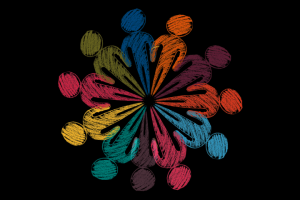South-South collaborations – a possible approach to academic exchange and innovation?
| 14 November, 2018 | Developers f1000 |

Rashmi Rodrigues MD, PhD, Associate Professor, Department of Community Health, St. John’s Medical College in Bangalore, India reflects on her experiences visiting Africa and the potential of growing South-South collaborations.
On the 3rd July 2018, the excitement of the upcoming academic visit overshadowed the stress of obtaining my visa to South Africa. I was visiting Uganda and then on to South Africa. I had lived with colleagues from Uganda during my doctoral studies in Stockholm, I even shared a PhD supervisor with one of them.
The first part of this trip was initially taking me to them to explore the possibilities of an academic collaboration. The second leg of my trip to South Africa was through an invitation to The African Academy of Sciencesannual DELTAS meeting, as part of concerted efforts between DELTAS Africa and the India Alliance to build bridges and provide networking/collaborative opportunities between researchers of both programs.
During my career as Faculty at a prestigious Indian medical school, I interacted with several medical students from high-income countries (HICs). I was also involved in initiating what is now called a north-south academic collaboration. I learnt that medical undergraduates and graduates from HICs visit India either to experience the sheer volume of patients or to have a real-life exposure to tropical medicine.
What’s interesting, however, is that HICs medical curriculum promotes, and encourages such exposures, whilst the Indian curriculum does not. As a rule, we in India, do not recognise the value of visiting another country, especially another low-middle income country (LMIC). Perhaps, this may happen when our focus shifts from curative care to public, global or international health.
Therefore, when the opportunity arose, I jumped at the chance to travel to Kampala, Uganda which included a visit to the prestigious Makerere University on route to Johannesburg.
Visiting Makerere University and its Lung Institute was a real eye-opener! Their collaborations are phenomenal, mostly with renowned Universities in HICs. Along with academic and economic development Makerere provides opportunities for travel to countries and institutions that would be a dream for any LMIC researcher.
Why then, I thought, would they want to collaborate with India? What did we have to offer? I had an idea that was piloted in India, to start an initiative for collaboration and travel to India. But then as I discussed possibilities with my potential collaborators who were equally enthused by it, we couldn’t ignore the elephant in the room, the question of ‘what next’? Will we have the funding to further the collaboration? But I believe in optimism and positivity and hoped that these issues could be overcome.

My positivity continued as I proceeded to Johannesburg for the DELTAS meeting. I was the first researcher from India to arrive and coincidentally travelled to the meeting venue with some senior African researchers. It was heartening to see how enthusiastic they were, and I hoped that I had made a good impression, as they had on me.
My enthusiasm however, waned slightly when I arrived. The conference began with groups of researchers from both India and Africa who naturally congregated in separate silos – not quite the image of ‘collaboration’ I was expecting! But when I thought back to the recent India Alliance meeting in Delhi that some African researchers had attended, I realised that this had been an issue there too and felt saddened by this disconnection. I questioned why this was the case, especially when we had all willingly signed up to the event with collaboration in mind. Could the issue be as simple as shyness or a fear of leaving one’s comfort zone? For me certainly it takes a lot of courage to infiltrate a group of strangers. Or was it something more portentous?
Whatever the reasons, I believe the bigger question is what measures and interventions can we put in place to discourage the practice of huddling with those we are most comfortable with at international conferences or meetings in general? Perhaps, we could make it a requirement and set targets for our sponsored participants to secure new contacts and possible collaborations from such meetings? Or provide training in communication/interpersonal skills tailored to navigate such situations at conferences/meetings? Whilst this might have been the case in some of the plenary sessions, I did witness fledgling collaborations being nurtured at various other levels, such as one-on-one meetings during breakfasts, dinners/lunches/coffee breaks, side meetings, meetings on request and future meetings/communications arising from exchange of business cards and contact addresses etc.
As I boarded my return flight home to India, I was grateful to my reading companion Hans Rosling’s “Factfullness” (here’s a great review of the book from Bill Gates). It gave perspective to my visit and made me really question the term ‘South-South’, that splits the world into two halves; the north and south, ‘the have’s’ and the ‘have-not’s’. South-South collaborations were collaborations between ‘have not’s’. It left me with the thought – would global collaborations, led by researchers in LMICs, supported by those in HICs, be a good idea instead? Or further should some south-south collaboration be promoted in academic ore research inisitions in LMICs. Certainly, time will tell!
For me, South-South collaborations enables researchers to see how similar local context affects their work, and this will certainly become more important as developing countries build and improve their own research capabilities. Success in collaborations can never be guaranteed. Each project will have its own internal tensions and external pressures. But one thing I am sure about is that the more these collaborative projects succeed, the greater the overall contribution of science to development.
On returning home, I reflected upon my visit and appreciated the very real desire and opportunities that are out there to strengthen scientific collaboration including The African Academy of Sciences, Africa-India Mobility Fund (AIMF). The AIMF is a two-year programme designed to provide researchers from Africa and India with opportunities for short visits in either direction to explore opportunities for building and strengthening scientific collaboration. And so, on the back of my meetings, we, researchers from St John’s National Academy, Bangalore and Makerere University, Kampala applied to the AIMF. This is in recognition of the fact that some African countries and India face similar challenges, both in the diseases that affect their populations and socio-political issues as well as the leadership required to address these.
We submitted two applications: one from St John’s National Academy of Health Sciences, with the emphasis on India to initiate a collaboration. The other from Makerere University, with the emphasis on Uganda to strengthen the collaboration.
Both the applications focus on a single research question ‘Is video observed treatment for supporting adherence to antitubercular treatment acceptable and feasible in patients with drug resistant tuberculosis in Uganda?’ The research will be implemented in two phases, providing both parties with an opportunity to visit each other. So, here’s to the next stage of what I hope is a burgeoning global collaboration.